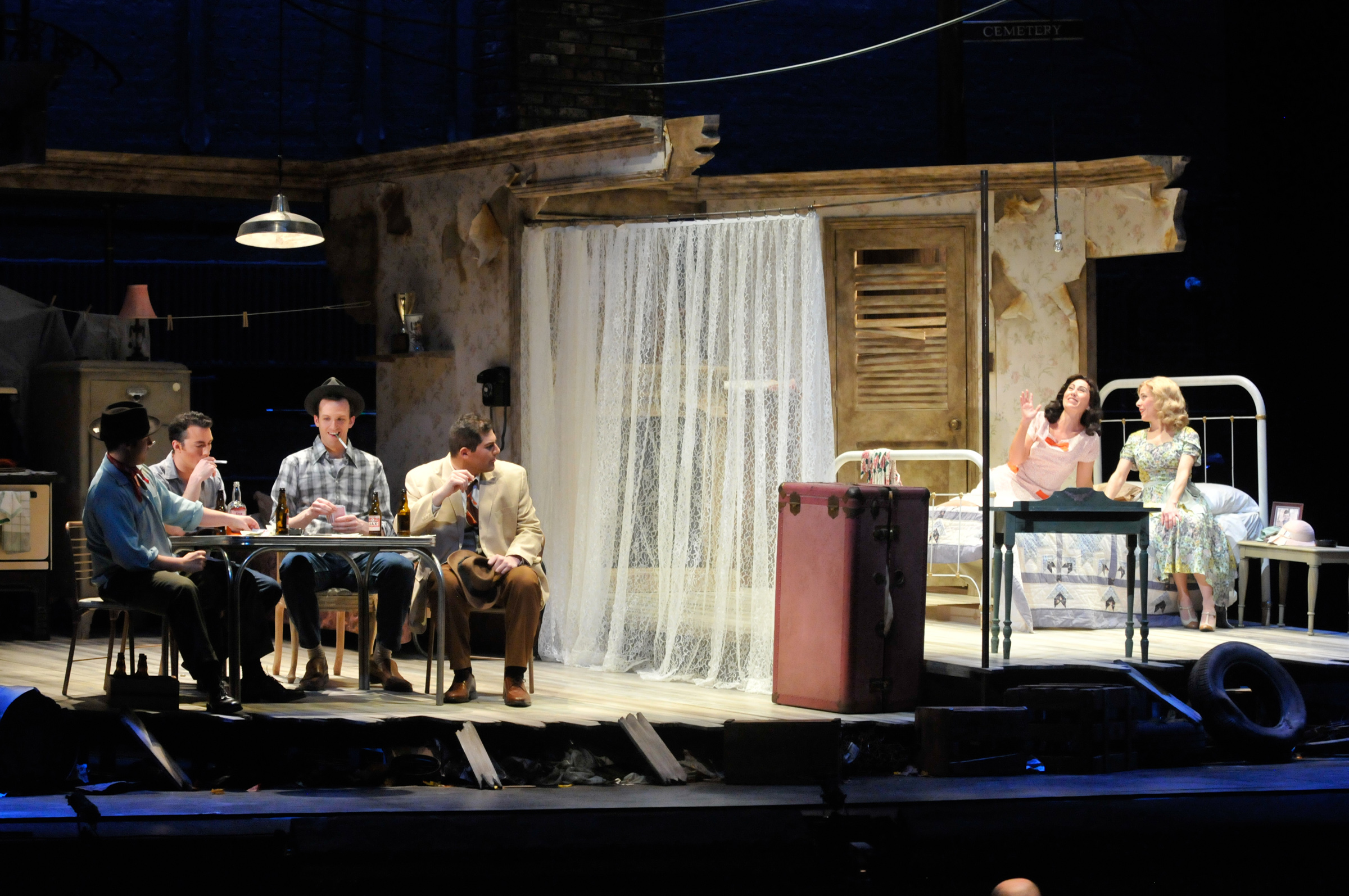Photo-Patrick Pfister.
A Streetcar Named Desire
Music by Andre Prévin
Libretto by Philip Littell
Directed by Jose Maria Condemi
Conductor, Joseph Mechavich
Review by Kathi E.B. Ellis
Entire contents copyright © 2015 by Kathi E.B. Ellis. All rights reserved.
The Kentucky Opera’s main stage season comes to an end with a production of a quintessentially twentieth century American story: Andre Prévin and Philip Littell’s remarkably faithful adaptation of Tennessee Williams’ A Streetcar Named Desire. A 1948 Pulitzer Prize-winning script. And, of course, if has been made into a movie – thrice. Asked about the movie, most people would reference the original with Vivian Leigh and Marlon Brando; but more recently Jessica Lange and Alec Baldwin stepped into those larger-than-life roles of Blanche and Stanley.
The Prévin/Littell opera premiered in 1998 – and, as operas go, this is positively brand new. Kentucky Opera’s 2014-2015 season has intentionally presented Louisville audiences with both unfamiliar classics and newer, hitherto unseen-locally works, three featuring American characters. Together with ATL’s commitment to telling stories of our community, and the Louisville Ballet’s commitment to American choreographers, Louisvillians have been presented with a great opportunity to embrace the diversity of American artists this season.
The excellent program notes provide audiences with an in-depth plot synopsis for those who are unfamiliar with Blanche’s story. The libretto is essentially Williams’ text. On occasion key phrases and words are repeated in a way that makes sense with the musical phrasing. There are also a handful of times that the text is spoken, reinforcing our sense that this is a story about characters whom we recognize and, possibly, know.
The arrival of Blanche (Maria Kanyova) upsets the fragile balance in the Kowalski home of sister Stella (Anya Matanovic) and her husband Stanley (Wes Mason). The relationship between Stella and Stanley is one of the most successful of this production. Matanovic and Mason embody the physical chemistry that keeps the two together, despite the dysfunction and violence within their relationship. In an early sequence Stella sings of her reliance on Stanley while applying cream to her arms, movement and melody combining to create the sensual need she has for him. Matanovic, throughout, brings fullness and warmth to her singing that fully realizes the earthy Stella, while Mason’s resonant baritone conveys the uncontrolled physicality with which Stanley faces his world.
Unfortunately, there was little chemistry between Blanche and Stanley that, if it were there from the beginning, provides the necessary inevitability of Stanley’s ‘we’ve had this date from the beginning’. Instead the cat and mouse game in Act Three lacks the intensity needed to escalate to the rape scene. Kanyova’s most successful scene is her attempted seduction of the newspaper collector (Dylan Crain in a delightful cameo). Here, the score combines with Kanyova’s real sense of impending doom for a brief glimpse of Blanche’s deteriorating emotional state. Blanche’s descent into madness, her lessening grasp on reality is less successful, both musically and from the performer. At too many moments there was the sense that Kanyova was fully in control of how Blanche was manipulating everyone, rather than the increasingly inept attempts of a woman who’s future is imploding. In this instance, the oft-implicit fragility of sopranos was not in evidence.
Mitch is played by Marco Cammarota in his professional debut (having been part of the Kentucky Opera’s Studio Artist program for two years). This performance grew on me. In his first scene with Blanche it was difficult to hear Mitch, but as Cammarota proceeded through the evening, his characterization gained stature, culminating in the painful scene between them once he knows Blanche’s background. Locally based Elizabeth Batton gives a performance full of attitude and tenderness as the upstairs neighbor who can handle the guys more successfully than either Stella or Blanche.
There is a level of cognitive dissonance between the seeing and the hearing in this twentieth century operatic story. There is such attention to the quotidian detail in the staging of the beer and whiskey drinking, cigarette smoking, card playing, glove putting on, etc. that the fully-formed operatic articulation is somewhat jarring – these are not characters who have high diction – nor do traditional opera characters take out the trash. The occasional suggestion of Blanche’s southern diction is a welcome nod to specificity of place. As an American opera, it is worth questioning how to balance traditional enunciation with a more contemporary interpretation of the libretto.
And there are those iconic moments of both play and movie that have to be embraced in any medium because audiences expect them, even if they know nothing else. The infamous ‘Stella’ cry is serviceable in this iteration. As in the other versions, it is spoken; but here Stanley has already sung her name as part of his in-the-moment contrition for striking her. It almost feels redundant. Maybe Prévin and Littell should have trusted to the power of music to carry this moment in the way that only opera could deliver. On the other hand, the reunion between Stanley and Stella that followed this was one of the most powerful and kinetic moments of the evening. The final scene of the story in which Blanche acknowledges that she has ‘always relied on the kindness of strangers’ was enhanced by the emphasis the score places on the previous phrase, ‘whoever you are’, which was repeated over and again not only as Blanche slowly crossed the stage to exit but also from backstage after her exit. The other characters were staged in tableaux, and the sense was that Blanche’s presence and broken absence would haunt them into the future. This was achieved in a way that a spoken word production could not, and was a heartbreaking coda to the evening.
Steven Kemp’s dilapidated setting provides the requisite claustrophobia for three people living in a two-room apartment (though the exits through the ‘walls’ during scene changes broke this convention at the preview I attended.) A particularly delicious aspect of the neighborhood was the dangerously cantilevering power-lines announcing ‘Desire’, ‘Cemetery’ and ‘Elysian Fields’. Costumes, Kristi Johnson designer, were suitably period, with the two sisters’ costumes clearly delineating their differences. The lighting of Eric Watkins created some interesting atmosphere as Blanche strove to keep harsh light from her face. Less successful was the use of a deep red wash not only for the rape scene but also for Blanche’s gut-wrenching admission of her liaisons; once can be compelling, but this felt like one too many times.
The biggest disappointment of this experience is that A Streetcar Named Desire is counter-programmed opposite the Louisville Ballet’s A Cinderella Story. Both the Kentucky Opera and the Louisville Ballet perform so rarely that is most unfortunate that their audiences may have to choose between these two productions this weekend, whether because of time or of money. It is to be hoped that David Roth and Robert Curran will be able to spread out their productions in future seasons so that Louisville arts aficionados have more choice of dates in order to take in both the opera and the ballet.
A Streetcar Named Desire
Friday, February 13, 2015 @ 8:00pm
Sunday, February 15, 2015 @ 2:00pm
Kentucky Opera
W.L. Lyons Brown Theatre
315 West Broadway
Louisville, KY 40202
Kyopera.org
 Kathi E.B. Ellis is a member of the Lincoln Center and Chicago Directors’ Labs and an associate member of the Stage Directors & Choreographers Society. She has attended the LaMama Directing Symposium in Umbria, Italy, and is featured in Southern Artisty, an online registry of outstanding Southern Artists. Her directing work has been recognized with nominations for the South Florida Theatre Carbonell Award. Locally, Kathi is a member of Looking for Lilith Theatre Company, a founding principal of StageLab theatre training studio, and is part of ShoeString Productions an informal producing collective. She has written book reviews and articles for Southern Theatre, the quarterly publication of the Southeastern Theatre Conference, and was a contributing writer for JCPS’ textbook for the 11th grade Arts and Humanities survey course and for YouthArts Tapestry, a Kentucky Arts Council publication.
Kathi E.B. Ellis is a member of the Lincoln Center and Chicago Directors’ Labs and an associate member of the Stage Directors & Choreographers Society. She has attended the LaMama Directing Symposium in Umbria, Italy, and is featured in Southern Artisty, an online registry of outstanding Southern Artists. Her directing work has been recognized with nominations for the South Florida Theatre Carbonell Award. Locally, Kathi is a member of Looking for Lilith Theatre Company, a founding principal of StageLab theatre training studio, and is part of ShoeString Productions an informal producing collective. She has written book reviews and articles for Southern Theatre, the quarterly publication of the Southeastern Theatre Conference, and was a contributing writer for JCPS’ textbook for the 11th grade Arts and Humanities survey course and for YouthArts Tapestry, a Kentucky Arts Council publication.




